James Maliszewski's Blog, page 75
May 18, 2023
My Top 10 Favorite D&D Magic Items (Part II)
Part I is here.
5. Portable Hole
One of the strengths of Dungeons & Dragons is that its conception of fantasy is quite broad, drawing not merely on the works of pulp fantasy, but also, in the words of Gary Gygax, on "countless hundreds of comic books ... [s]cience fiction, fantasy, and horror movies ... fairy tales ... books of mythology ... bestiaries ... compilations of the myths of various peoples" – and, if the portable hole is any indication, Looney Tunes cartoons as well! This is a terrific example of a magic item that is both genuinely useful and fun and I wish there were more like it in the game.
4. Wand of Wonder
I love a little bit of randomness and unpredictability in my games. The wand of wonder brings them in spades. Every time this magic item is used, percentile dice are rolled to determine which of nearly twenty different effects occur: anything from summoning a rhino (or a mouse) to a stream of 600 butterflies pouring forth to a fireball – and more. This is another fun item, one that I've enjoyed seeing used in play many, many times over the years.
3. Ioun Stones
This is a double cheat, I suppose, since it's both a collection of related items and not original to Dungeons & Dragons, since ioun stones first appeared in the work of Jack Vance. Of course, these facts are a big part of why I so love ioun stones. Like figurines of wondrous power, the variety of the stones is a point in their favor. The same is true of their Vancian origins, since Vance is one of my favorite Appendix N authors (and Gygax's too). Consequently, I've included numerous ioun stones in my campaigns over the years and imagine I will continue to do so in the future.
2. Bag of Holding
I almost placed this in my number 1 spot, since it's one of those magic items that has appeared in nearly every D&D campaign I've run or played in since 1979. The reason I didn't is that the bag of holding is a thoroughly gamey magic item, one that exists almost entirely to circumvent a very common problem, namely, how to lug around large amounts of gold and other treasure without becoming encumbered. There's nothing wrong with that. D&D is a game, after all, but I generally like my magic items (and monsters and spells ...) to exist largely, if not solely, for setting reasons rather than game reasons. Still, this is a great and iconic magic item and deserves to be on this list.
1. Deck of Many Things
Depending on your point of view, the deck of many things is either the most entertaining magic item in all of D&D or a Killer DM's dream come true. In my opinion, it's both, at least potentially so – and that's why I've given it the top spot on my list. I can think of no other magic item that simultaneously elicits both greed and terror in players. The potential rewards for drawing a "good" card are great, as are the dangers of drawing a "bad" one. The discovery of a deck of many things in a treasure hoard is practically an adventure unto itself, as players tie themselves into knots trying to decide whether or not their characters should risk picking a card (or four). This is everything a good magic item should be – wondrous, dangerous, capricious.

May 17, 2023
My Top 10 Favorite D&D Magic Items (Part I)
Since "My Top 10 Favorite D&D Monsters," Parts I and II, were so well received last week, I thought it might be fun to follow them up with a couple of posts in which I talked about my favorite magic items. As with the monsters, I'll try to stick to magic items that are unique to Dungeons & Dragons, though, as you'll see, several of the items in question were inspired by prior works. All of these items come originally from OD&D or AD&D, but then that should hardly be a surprise to anyone reading this. Sadly, almost none of these magic items had an illustration to accompany it in its original appearance, so these posts won't be quite as visually appealing as their predecessors.
10. Sword +5, Holy Avenger
First appearing in Supplement I to OD&D (which, not coincidentally, also introduced the paladin class to the game), the Holy Avenger is, in the hands of its intended user, a very potent weapon, conferring 50% magic resistance in a 5' radius, dispelling magic in a 5' radius, and dealing +10 damage against chaotic evil opponents. My fondness for it is colored, no doubt, by the fact that my first D&D character eventually obtained this mighty weapon, which he used to good effect in his battles against the forces of the Abyss. The Holy Avenger is arguably overpowered even by AD&D standards, but it brings with it a lot of flavor, which is more than can be said of most magical weapons.
9. Elven Cloak and Boots
This is a bit of a cheat, in that it's actually two items, but, because the Holmes edition of D&D listed them together on its miscellaneous magic items table, I tend to think of them as a unit. Conferring near-invisibility and silent movement respectively, the elven cloak and boots were probably inspired, at least in part, by the cloaks Galadriel gave to the Fellowship in the first volume of The Lord of the Rings. Despite this likely origin, I'll always consider them distinctively D&D magic items, because of how commonplace they were as a treasure in low-level adventure modules. They're also pretty darned useful.
8. Sphere of Annihilation
How's that for whiplash? The sphere of annihilation is a favorite of mine for two reasons. The first is that the use – or misuse, depending on your point of view – of this magic item played an important role in a campaign I refereed to great success in the early to mid-1990s. The second is that the sphere, like many of the best magic items, is both powerful and unpredictable. Successfully employing it depends on a magic-user's level and Intelligence score and, even under ideal circumstances, there's still a reasonable chance things will go awry. Plus, opposing magic-users can fight for control of the sphere, which always struck me as pregnant with potential.
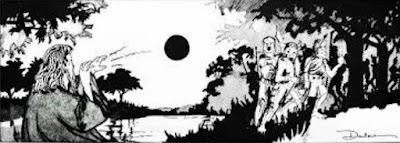 7. Gauntlets of Ogre Power
7. Gauntlets of Ogre Power
This is another staple of low-level adventure modules and understandably so. Not only are they quite useful to fighters, they have a nicely mythic quality to them, like something Siegfried might have found in Fáfnir's hoard. Gauntlets of ogre power also play an important role in the history of Morgan Just, a character from the earliest days of playing D&D with my friends.
6. Figurines of Wondrous Power
I suppose this, too, might be considered something of a cheat, because it's actually a category of magic item, coming in seven different forms. In truth, that's precisely why I like them. There's something very fun about the fact that these are magic items that can appear again and again and yet never be precisely the same thing twice. Equally fun is the fact that they're little animal statues that come to life and perform useful tasks for their owner. The figurines remind of something that might appear in a fairy tale and I think that's just great.
RIP Russ Nicholson
Russ Nicholson, the artist whose illustrations contributed greatly to the overall vibe of the Fiend Folio, has died. News of his death began to circulate earlier today and, while precise details are still sketchy, I am nevertheless greatly saddened.
Nicholson's art is incomparable. The interplay of darkness and light, combined with a remarkable level of detail, set it apart from the work of anyone else in the field of fantasy and science fiction illustration. I had the good fortune to correspond with Russ on several occasions and he was always generous with his time and talents – a gentleman and a true professional.
Over the next few days, I suspect we'll see plenty of heartfelt tributes to Nicholson's life and artwork and rightly so. We'll also see posts praising favorite examples from his immense body of work, many of which contributed immeasurably to the distinctive esthetic of "British fantasy" as exemplified by White Dwarf, Fighting Fantasy, and Warhammer, among many others.
I'd have a hard time choosing a single Nicholson illustration as my favorite, because he created so many wonderful works. That said, I have a personal fondness for the illustration below, which I commissioned for my Thousand Suns science fiction RPG years ago. Now that Russ is no longer with us, my attachment to it has only grown.
Rest in peace, Mr Nicholson!

Retrospective: Death's Ride
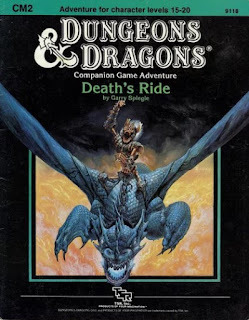 Over the years, I've mentioned my affection for the third boxed set released as part of Frank Mentzer's revision of Dungeons & Dragons, the Companion Rules. The reason for my affection is quite simple: the Companion Rules were an attempt to restore D&D's lost endgame in a way that was accessible and fun for a new generation of players. While reasonable minds can differ about how successful Mentzer was – I judge it a partial success – I hope it's not controversial to say that his attempted restoration may have been the last time that any version of Dungeons & Dragons took seriously the idea of player characters establishing and ruling domains (or "baronies," as OD&D calls them). [I seem to have forgoten the existence of the Birthright campaign setting from the '90s. Silly me – JM]
Over the years, I've mentioned my affection for the third boxed set released as part of Frank Mentzer's revision of Dungeons & Dragons, the Companion Rules. The reason for my affection is quite simple: the Companion Rules were an attempt to restore D&D's lost endgame in a way that was accessible and fun for a new generation of players. While reasonable minds can differ about how successful Mentzer was – I judge it a partial success – I hope it's not controversial to say that his attempted restoration may have been the last time that any version of Dungeons & Dragons took seriously the idea of player characters establishing and ruling domains (or "baronies," as OD&D calls them). [I seem to have forgoten the existence of the Birthright campaign setting from the '90s. Silly me – JM]I've long suspected that one of the reasons the original endgame of D&D was abandoned by both the game's publisher and its players is that there were never any good examples of what characters did once they cleared a wilderness hex, built a fortress, and settled down to ruling. The promise of the Companion Rules was that they might go some way toward correcting this oversight and, in my opinion, they did, albeit with some qualifications. Of course, I had hoped, as I expect many other D&D players at the time did, that the Companion-series adventures would go even further, providing multiple, clear illustrations of how to run a Dungeons & Dragons campaign centered around high-level, domain-ruling characters.
Sadly, like the Companion Rules themselves, what TSR offered instead was a very mixed bag that did little to clarify the situation. Indeed, if 1984's Death's Ride is any indication, Companion-level D&D was just like lower-level D&D but with more dangerous monsters, more potent spells, and more valuable treasure. It's a real shame, because there was – and is – a need for guidance on this level of gameplay and the ways in which it differs from lower-level campaigns. That's certainly what I was looking for in the CM-designated modules, which is why I bought so many of them during the period when they were being published.
Written by Garry Spiegle, an author I remember mostly for his work on the second edition of Gamma World, Death's Ride takes place in the distant mountain-based Barony of Twolakes Vale. The barony, it seems, has gone silent recently. This includes the cessation of tax payments to the King of Norwold, which naturally raises his concern. Since the barony is remote, he tasks the player characters (who are assumed to be between levels 15 and 20), to investigate the situation and resolve it, if possible. In return, the characters will receive a large monetary reward and the king's gratitude.
As you can probably already see, the set-up of the adventure does not assume the characters already have baronies of their own to rule, treating them instead just like rootless adventurers in search of another patron. Actually, that's not entirely true. The introductory "How to Use This Adventure" section briefly alludes to this possibility when it cautions:
Some player characters may want to lead large bodies of troops, retainers, or hirelings in this adventure. Don't let too many characters get caught up in this, as it can bog your game down in a mire of detail. Encourage your players to concentrate on their own characters.
While I find the advice odd, it's important to remember that the Companion Rules are not aimed solely at domain-ruling characters. They, in fact, introduce quite a number of interesting and unique options for adventurers who reject becoming tied down by the demands of rulership and that's fine. What irks me, now and then, is that modules like Death's Ride offer so little for characters who do decide to take up rulership. I think the adventure might have been more useful on several levels if, instead of detailing a threat to an NPC's barony, it had instead detailed one to a player character's. I realize that would have required more work on Spiegle's part, given the likely variability for which he'd need to account, but it would have expanded the utility of Death's Ride immensely.
The Barony of Twolakes Vale languishes under "the Deathcloud," a roiling, black magical phenomenon that has alighted upon the area because a pair of evildoers have opened a portal to the Sphere of Death – an otherplanar realm that is the source of negative energy and, therefore, undead. The Barony is thus overrun with a veritable army of the undead, not to mention a dragon in league with the two main antagonists. The characters thus have their work cut out for them, with plenty of fighting against enemies both powerful and numerous. The result is a bit of slog in keeping with the mantra of "More! Bigger!" that unfortunately characterized Mentzer's Companion, Master, and (Gygax preserve us) Immortals rules.
As I said earlier in this post, it's all a great shame, because, in principle, an adventure like this has potential. The premise of an evil cleric and an evil wizard joining forces to open a portal to a nightmarish Other World filled with undead isn't a bad one – all the more so when they do so in the domain of a player character. The challenge of overcoming enemies of this sort while at the same time working to limit the damage they can do to one's own holding is a significant one worthy of a high-level character. I would have loved to read such an adventure. Instead, what we got was a fairly unimaginative slugfest without any personal stakes for the characters beyond the quest for every greater gold and XP. Alas!
May 16, 2023
Attention, Traitors!

West End's Paranoia is a roleplaying game of which I have many fond memories. It's also a game I haven't played in, literally, decades and doubt I'll ever play again. Part of that is that I no longer own a copy of the rules, but a bigger part is that I'm not at all sure how well a RPG like this would work in the present day. The real world is already so uncomfortably close to Paranoia's "darkly humorous future" at times that I wonder if it's even possible to satirize it effectively.
I understand that there's a new edition of the available through Mongoose Publishing, though I've not seen it and so can't speak to how effectively it translates the irreverent and subversive spirit of the original into the very different world of the 21st century. If anyone has any experience with it, I'd be curious to hear your thoughts on it.
May 15, 2023
White Dwarf: Issue #74
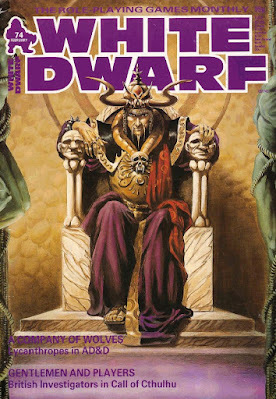 Issue #74 of White Dwarf (February 1986) sports a cover by American conic book artist, Frank Brunner, who's probably best known for his work on Creepy, Eerie, and Vampirella, as well as his covers for Marvel's Savage Sword of Conan and Red Sonja. The issue also marks the point where Ian Livingstone hands over day-to-day editorial duties to Ian Marsh. Livingstone states that he is not "deserting the magazine" and will still "be keeping a benevolent eye on the progress of [his] eight-year-old love-child" in his new capacity as Editor-in-Chief. Despite his reassurances, this nevertheless feels like a turning point in the history of White Dwarf.
Issue #74 of White Dwarf (February 1986) sports a cover by American conic book artist, Frank Brunner, who's probably best known for his work on Creepy, Eerie, and Vampirella, as well as his covers for Marvel's Savage Sword of Conan and Red Sonja. The issue also marks the point where Ian Livingstone hands over day-to-day editorial duties to Ian Marsh. Livingstone states that he is not "deserting the magazine" and will still "be keeping a benevolent eye on the progress of [his] eight-year-old love-child" in his new capacity as Editor-in-Chief. Despite his reassurances, this nevertheless feels like a turning point in the history of White Dwarf.Case in point: the issue kicks off with "Superpower" by Bruce Hollands, which is an extensive look at the Games Workshop-published boardgame of the same name. Like the look at Warrior Knights from the previous issue, this article, while informative, nevertheless feels more like an extended advertisement for a GW product than a "real" article. That may be an unfair judgment on my part, but reading it convinced me that the oft-discussed transformation of White Dwarf into a full-on house organ of Games Workshop was not far in the future.
Countering that worry is "Open Box," which only reviewed one GW product this issue, the Call of Cthulhu scenario Night in Norway, which scores 7 out of 10. Also reviewed is Dragon Warriors and two of its supplements (The Way of Wizardry and The Elven Crystals), which collectively earn 9 out of 10. After all these years, I've still never read Dragon Warriors, which people whose opinions I respect tell me is well worth a look. The historical RuneQuest supplement Vikings gets 8 out of 10, while Oriental Adventures for AD&D receives 9 out of 10. The Pendragon Campaign, the predecessor to the well regarded The Boy King, is similarly well regarded, earning 9 out of 10. The column wraps up with a look at two different scenarios for use with FASA's Star Trek , The Outcasts and Termination 1456, both of which are judged perfect (10 out of 10).
Dave Langford's "Critical Mass" generally vexes me, but this issue's column at least looks at a few books I know and have read, like Jack Vance's Planet of Adventure series. Langford quite correctly recognizes the value of these books and of Vance more generally
The good stuff lies in Tschai's rich scents and colours, and in elaboration of style. No Vance villain would say 'I'll get you for that.' Instead: 'Low-grade assassins will drown you in cattle excrement! Twenty pariahs will drub your corpse! A cur will drag your head along the street by your tongue!'
Langford's byline reappears under "The Power of the Frog," a science fiction short story about a human junior military officer held prisoner by an alien race. Like all of Langford's previous short stories, this one is both brief and amusing. It's clear the man has talent, which is why I sometimes feel bad at the lack of interest his book review column elicits. Truthfully, I wish he had contributed more fiction to White Dwarf.
"Terror at Trollmarsh" is an AD&D adventure for 4th–5th-level characters by Peter and Janet Vialls. I really enjoyed this one, which takes the form of a murder mystery with fantasy/horror elements. A monster is stalking the halls of Baron Uther Torgrim, killing his servants, and it's up to the players to figure out just what is really going on. While the overall concept is a standard, even clichéd one, the authors handle it well, giving the referee an interesting, well mapped out environment, an array of compelling NPCs, and a culprit with clear, understandable motives. "Terror at Trollmarsh" is nothing revolutionary, but, like all good scenarios, it gives players lots of "moving parts" with which to interact as they grapple with its central mystery.
"A Company of Wolves" by Peter Blanchard looks at lycanthropy in AD&D from both a game and folkloric perspective. The article doesn't offer much in the way of new rules mechanics, which I appreciate, focusing instead on "social" aspects of this magical curse, which is to say, how it might function in a fantasy setting, including its advantages and drawbacks. "The Hide of the Ancestor" by Chris Watson is a short RuneQuest scenario about the recovery of a relic holy to the twenty-six tribes of the Ithillian-Fane, a race of lion-centaurs. I find it oddly refreshing to read a RQ adventure set in Glorantha whose author feels comfortable enough with the setting to his own creations, like the Ithillian-Fane to it. Too often settings like Glorantha – and Tékumel and Hârn and ... – are treated as inviolable to the point that no one is even willing to play in them, lest they "do it wrong." That's nonsense in my opinion, which is why I delight in scenarios like "The Hide of the Ancestor."
"Gentlemen and Players" by Richard Edwards and Chris Elliott is nice little article about creating British characters for use with Call of Cthulhu. As its title suggests, the article focuses on the creation of "gentlemen" (or aristocratic amateurs) and "players" (professional sportsmen). "Hitting the Right Note" by Ian Berridge presents information on musical instruments, their use, and the how to learn to play them for use with AD&D. Articles like this are godsends to those whose campaigns would benefit from such fine details – and absolutely useless to those whose campaigns wouldn't.
"Alternative Origins" by Ian Thomson is a collection of random tables for use with Games Workshop's Golden Heroes. The tables are intended to replace those presented in the game for character generation in order to produce more "convincing" heroes whose powers are an incompatible jumble. This makes good sense to me, but then I haven't looked at a copy of Golden Heroes in decades, so it's hard for me to judge how useful this article would be. Elsewhere, Joe Dever offers part three of his look at "Dioramas," accompanied by some lovely – though non-diorama – photographs of painted miniatures.
The issue also includes more "Thrud the Barbarian," a full-page "Gobbledigook," and "The Travellers," which continues its Shadows-inspired plotline. I particularly enjoyed the latter, especially this bit:
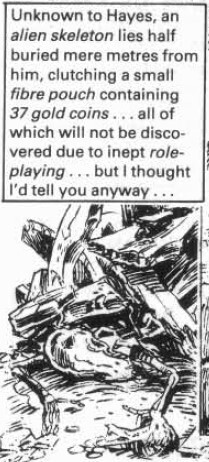 Of course, I've always been fond of the way that "The Travellers" blends Traveller-specific humor with more general lampoonery of roleplaying games, so I may be biased. In any case, it's nice to see that one of my favorite comics remains as amusing ever, even if White Dwarf as a whole looks to be on the verge of some monumental – and not entirely pleasing – changes.
Of course, I've always been fond of the way that "The Travellers" blends Traveller-specific humor with more general lampoonery of roleplaying games, so I may be biased. In any case, it's nice to see that one of my favorite comics remains as amusing ever, even if White Dwarf as a whole looks to be on the verge of some monumental – and not entirely pleasing – changes.
May 12, 2023
300
 My House of Worms Empire of the Petal Throne campaign reached another milestone yesterday: 300 sessions! The pace of our (theoretically) weekly meetings has admittedly slackened a bit over the past year, owing to a variety of real-world considerations, but the seven players and I continue to enjoy ourselves and our exploration of the world of Tékumel.
My House of Worms Empire of the Petal Throne campaign reached another milestone yesterday: 300 sessions! The pace of our (theoretically) weekly meetings has admittedly slackened a bit over the past year, owing to a variety of real-world considerations, but the seven players and I continue to enjoy ourselves and our exploration of the world of Tékumel. Of course, the campaign has been "off the map" of known Tékumel for a very long time now, with the player characters located on the Achgé Peninsula of the mysterious Southern Continent since mid to late 2016 (about a year into the campaign). During that time, they've been interacting with a couple of non-Tsolyáni cultures that are largely or wholly of my own invention and dealing with problems that are only tangentially related to those of the Five Empires.
Yesterday, the campaign (unintentionally) reached an important crossroads. For the past several weeks, the characters had been exploring a strange tower located within a béthorm (pocket universe), trying to determine to whom it belonged. As it turned out, the tower was the dwelling place of a sorceress who called herself Tomorónore and claimed to be the wife of an old frenemy of theirs, the wizard Getúkmetèk. Like her husband, she didn't think much of the extraplanar entities that had set themselves up as the gods of Tékumel, feeling that they were deliberately retarding the development of mankind and the other intelligent species of the planet. She was thus a member of the cabal of Undying Wizards known as the Accelerators, who sought to challenge the power of Tékumel's so-called deities.
Unlike her husband, though, Tomorónore prefers subtle action against the gods rather than the more direct methods favored by Getúkmetèk. That's why she offered the characters a deal: abandon their current alliance with her husband's younger self – time travel and parallel Tékumels are involved and it's best not to worry about the details – and she would see to it that they were initiated into the Accelerators and given the knowledge they craved about the True Nature of Things™.
At the end of yesterday's session, it seemed as if the characters might take her up on her offer. After eight years, I think the players are keen for a change of pace – "epic level play," as one of them described it. Truth be told, I think I am ready for a change, too, which is why I had Tomorónore make the offer in the first place. Change always brings with it a degree of risk; the ever-present fear that, by indulging in change, I may inadvertently destroy what we've built over the course of the years. Having the characters leave behind the mundane aspects of Tékumel for the rarefied heights of interaction with demons and gods and the great mysteries of the setting will be very different from what we've done thus far.
Wish us luck!
May 11, 2023
My Top 10 Favorite D&D Monsters (Part II)
Part I is here.
5. Shambling Mound
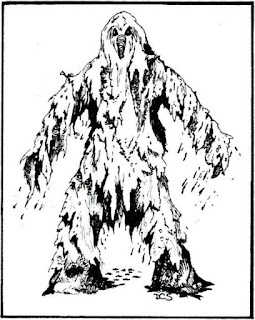
According to Gary Gygax, the shambling mound was inspired by the 1940s comic book monster, the Heap, which seems plausible, given that the Monster Manual states that it "appear[s] as a heap of rotting vegetation." My own fondness for the shambler stems from my love of all manner of swamp monsters, most especially Père Malfait from the Kolchak episode, "The Spanish Moss Murders." There's no denying that there's something positively primal about the idea of a monster rising out of the muck of a dismal marsh to attack unsuspecting travelers through its domain. As a referee, I've made good use of these creeps over the decades.
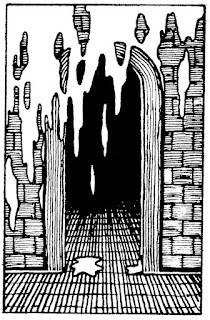 4. Green Slime
4. Green SlimeIn a sense, I owe my playing of D&D to green slime. As you may recall, my earliest experience of fantasy gaming came through the boardgame Dungeon! One of my favorite aspects of that game were the monster cards that you flipped over whenever your token entered a space on the map. Mixed in with goblins, giant rats, and skeletons were a number of weirder enemies that captivated my youthful self. Chief among these was green slime, which was a truly nasty opponent, being immune to fireballs and requiring double digit rolls to kill for all attacks except lightning bolts. The D&D version of green slime isn't quite as hard to destroy, but it's still plenty dangerous, turning living beings it touches into more green slime – no resurrection possible. Yikes!
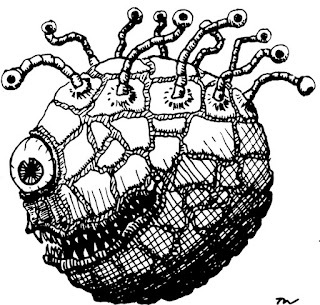
3. Beholder
The beholder has to be a strong candidate for the most iconic D&D monster ever. That said, they've rarely appeared in my own games over the years, partly because they possess a wide array of dangerous abilities. Yet, there's no denying beholders are an imaginative and compelling monster – among the best in the game – which is why I've ranked them so highly on this list.
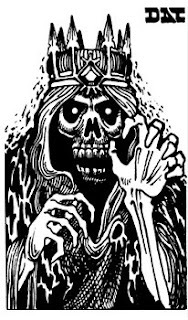
2. Lich
Arguably this monster is a violation of my own rules, since the idea of an undead sorcerer is hardly unique to Dungeons & Dragons. I readily admit my hypocrisy on this point, but I don't care. Moreso than almost any other "standard" D&D monster I can think of, the lich draws deeply from the game's pulp fantasy roots and that's a big part of why I love it. I also have lots of great memories of liches from adventures I ran in years past, like Asberdies from Descent into the Depths of the Earth (and Acererak from Tomb of Horrors – yes, I know he's a demi-lich, but, since we've already established I'm a hypocrite, why not include him too?).
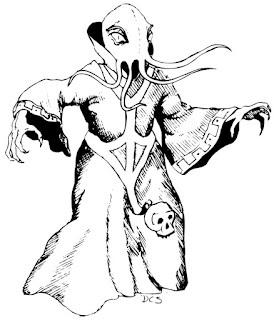 1. Mind Flayer
1. Mind FlayerThis was an easy one for me. The Cthulhoid stylings of the mind flayer held instant appeal the first time I gazed upon Dave Sutherland's illustration in the Monster Manual. The fact that these monsters used psionics was another point in their favor, since I was strangely fascinated with AD&D's convoluted (and largely unworkable) system for handling psychic powers. Like the lich, the mind flayer is highly intelligent, but its intelligence is of an inscrutable, alien sort that gives the monster a little extra oomph, hence its place in the top spot of this list.
May 10, 2023
My Top 10 Favorite D&D Monsters (Part I)
In the interests of narrowing the scope of potential candidates for this list, I established a few rules for myself. First and most importantly, I would only select from monsters unique to Dungeons & Dragons. That means, mythological or folkloric monsters, like minotaurs or goblins, were excluded from consideration, even in cases where D&D's version of them is idiosyncratic (e.g. kobolds). Second, monsters of a singular type, such as named demons or devils, were likewise excluded. Finally, any edition of Dungeons & Dragons was fair game, though, given my age and preferences, I hope no one will be surprised that all of the monsters I chose first appeared in either OD&D or AD&D 1e.
As with all of my previous Top 10 posts, this list comprises my personal favorites – a purely subjective category. I do not, therefore, suggest that any of these monsters are the "best" by any other measure. Indeed, several of those included, as you'll soon see, are, in fact, quite silly by any charitable definition, but I have a fondness for them born of more than four decades of play. No doubt many of you reading this will have your own favorites of a similar sort.
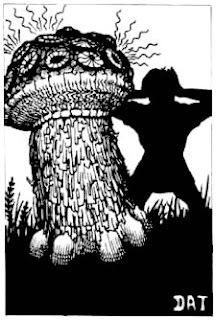 10. Shrieker
10. Shrieker
The shrieker is one of those silly monsters I mentioned earlier. It's a mindless, ambulatory fungus that emits a piercing shriek when either a light source is brought within 30' of its location or there is movement within 10'. The noise has a 50% chance of attracting wandering monsters each round that it shrieks. I first came across shriekers in the pages of the J. Eric Holmes-edited Basic Rules and, which may explain why I consider them – and fungi more generally – a quintessential aspect of the play of D&D. I suspect shriekers aren't very popular with most gamers, since they exist entirely to screw with reckless or incautious players. That's exactly why I do like them and include them in most of the dungeons I've made over the years.
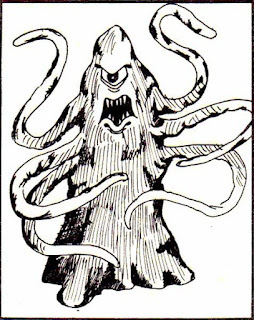
9. Roper
While I wouldn't call the roper "silly," it is a little goofy. It's also a little bit scary too, since, according to its description in the AD&D Monster Manual, it can disguise itself as a pillar or stalagmite in order to better attack its unsuspecting prey. Its natural form is that of a one-eyed slimy mass of arms with a huge fang-toothed maw. I wouldn't go so far as to say it's nightmarish, but it's definitely not something I'd like to encounter under any circumstances. On the plus side, it often has platinum pieces and gems in its gizzard, which is very D&D.
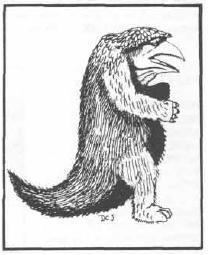 8. Owlbear
8. Owlbear
The owlbear is not a silly monster, as anyone familiar with either owls or bears could tell you. Unfortunately, its illustration by Dave Sutherland does little to convey just how terrifying such a creature would be, were it to exist in the real world. I like owlbears because they're just fantastical enough that they nicely convey the "we're not in Kansas anymore" vibe that any good fantasy setting should have, while also being sufficiently mundane that their widespread presence within the Forest of Doom doesn't seem implausible. Their existence also implies that wizards get up to weird stuff – another must have in any decent fantasy setting.
7. Carrion Crawler
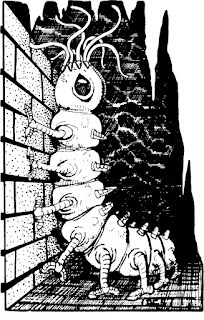 I am a well known enjoyer of vermin and the carrion crawler, as its name suggests, is a frightfully hopped up example of them. It's also, despite having only 3+1 Hit Dice, an exceptionally dangerous opponent. Each of its eight tentacles gets an attack and each is capable of inflicting paralysis with a hit on anyone unlucky enough to fail a saving throw. I can still vividly recall an early encounter with a carrion crawler that nearly resulted in a total party kill. That left my younger self with a healthy level of respect for carrion crawlers – not to mention the belief that they were perfect monsters to include in my own dungeons. Dave Sutherland depicts them in the Monster Manual as a kind of Cthulhoid caterpillar, which is bonkers in the way that the best D&D monsters should be.
I am a well known enjoyer of vermin and the carrion crawler, as its name suggests, is a frightfully hopped up example of them. It's also, despite having only 3+1 Hit Dice, an exceptionally dangerous opponent. Each of its eight tentacles gets an attack and each is capable of inflicting paralysis with a hit on anyone unlucky enough to fail a saving throw. I can still vividly recall an early encounter with a carrion crawler that nearly resulted in a total party kill. That left my younger self with a healthy level of respect for carrion crawlers – not to mention the belief that they were perfect monsters to include in my own dungeons. Dave Sutherland depicts them in the Monster Manual as a kind of Cthulhoid caterpillar, which is bonkers in the way that the best D&D monsters should be.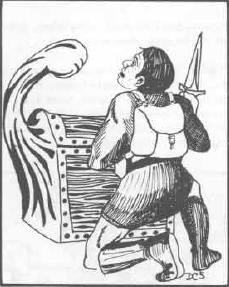 6. Mimic
6. Mimic
A lot of people seem to think the mimic is a silly monster, but they're wrong. Certainly the mimic owes its existence to a referee's desire to mess with thieves and that might rub some people the wrong way (mostly the players of thieves). On the other hand, mimics are (in my opinion) another fine example of wizards getting up to weird stuff and that's all to the good. My main regret about the mimic is that too many people seem to think they can only shapeshift into chests. That vastly underestimates their utility and I wish more referees included mimicked chairs, tables, doors, and so on in their dungeons. That said, the mimic chest is a classic for a reason, though Sutherland gets bonus points for eschewing the obvious and instead having the monster punch the hapless thief who got too close to it.
Tunnels & Trolls News
Several readers contacted me this morning to draw my attention to some big news on the Tunnels & Trolls front.
World-renowned independent creative studio Rebellion is delighted to announce the acquisition of Tunnels & Trolls, one of the trailblazing games of the fantasy genre, and the second roleplaying game ever published.
First published in 1975 by Flying Buffalo as a more player-friendly alternative to Dungeons & Dragons, Tunnels & Trolls introduced roleplaying to new audiences through its streamlined mechanics and pioneering approach to solo roleplaying. Now, almost 50 years after its original publication, the Rebellion Unplugged team is bringing Tunnels & Trolls into a new era.
“Tunnels & Trolls is an unrecognised trailblazer in the games industry”, said Duncan Molloy, head of Rebellion Unplugged. “The team at Flying Buffalo responded to an entirely new medium by focusing on how roleplaying could be more approachable, more accessible, and more fun. So much of the modern era of roleplaying from old school hacks, to streamlined systems, to solo play, can directly trace its roots directly back to this series. We’re very excited to channel that spirit in bringing Tunnels & Trolls into the modern era.”
“When I first discovered Tunnels & Trolls in the mid-1970s, I didn’t realize I was unlocking a life-long interest in fantasy roleplaying games, books, movies, and all things genre-based” recalled Rebellion CEO and Creative Director Jason Kingsley OBE, “The game has remained with me throughout my life, and I can’t wait to see what the team have in store for it!”
After the passing of Flying Buffalo founder Rick Loomis, the company had been taken over by Webbed Sphere Inc. “We are very excited to see Rebellion expand this rich property” added Jon Huston, president of Webbed Sphere. “As a long-time fan, I always felt that the Flying Buffalo roleplaying lines had such incredible potential.”
As part of the acquisition Rebellion have taken over Flying Buffalo’s entire line of roleplaying games, including the cult classic Citybook, Grimtooth, and Merchants Spies and Private Eyes series. The entire back-catalogue of Flying Buffalo PDFs will remain available to purchase online, with future releases coming directly from Rebellion Unplugged.
This is potentially big news, especially if Rebellion makes a serious go of publishing and promoting Tunnels & Trolls and other Flying Buffalo RPG properties. I find it interesting, though, that the name of T&T's creator, Ken St. Andre, appears nowhere in this press release or anywhere else on the Rebellion website. Even if he's not involved in the future development of the game, I nevertheless would have expected him to be mentioned, perhaps with a quote about how happy he is that his baby is now in safe hands.
Regardless, I'll be keeping my eye on this story.
James Maliszewski's Blog
- James Maliszewski's profile
- 3 followers



